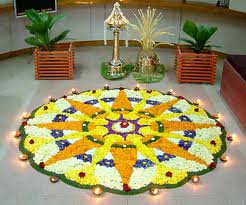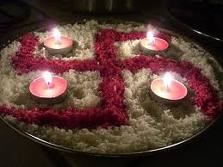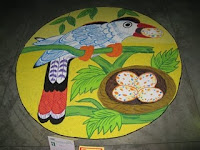 We have a large variety of alternative that can used to make Rangoli designs.
We have a large variety of alternative that can used to make Rangoli designs.You can also experiment and mix and match materials after all creative mind never exhaust. These materials may be coloured as per need.
Rangoli colours
Readily available in the market.
Marble dust.
Gives good result, but very heavy to carry in bulk.
Saw dust
Sawdust is easier to handle. Even floats on water.
Coloured rice
Can be used as it is or grinded for fine texture .You can also colour rice at home using food colours. Wet the food colour powder with a few drops of water and rub the rice in it till it is uniformly coloured. Do not forget to wear gloves to protect your hands from getting coloured. Dry the rice on paper, in shade before use. (Caution: If the rice is not completely dry it may leave coloured stains on the floor.)
Coloured Suzi/rawa/cream of wheat
Nice grains(harder than saw dust) easy to spread.. but doesn’t mix too well with color.. Bouncier than color- thus may give a slightly whitish haze.. But good part is it is hygroscopic. If you want, the it to stay longer than a day this is the medium to use

Petals
Rose petals, marigold petals, small purple paper flowers, finely cut greens-grass/ leaves-even methi leaves...just fill up the large designs. Use strings of marigold and if you like strings of kanakambara/ jasmine flowers to outline

Fabric or poster colour mixed with chalk powder
Mix a small quantity of colour with chalk powder. Apply it with brush on the floor. It just looks like painting on floor ….not a traditional form of Rangoli , but it is scores over as it is very easy and is relatively permanent in nature
Coloured stones
Use this only for big and abstract Rangolis as finesse is not possible with such materials
![]()
If you like this please Link Back to this article...












0 comments:
Post a Comment
Note: Only a member of this blog may post a comment.